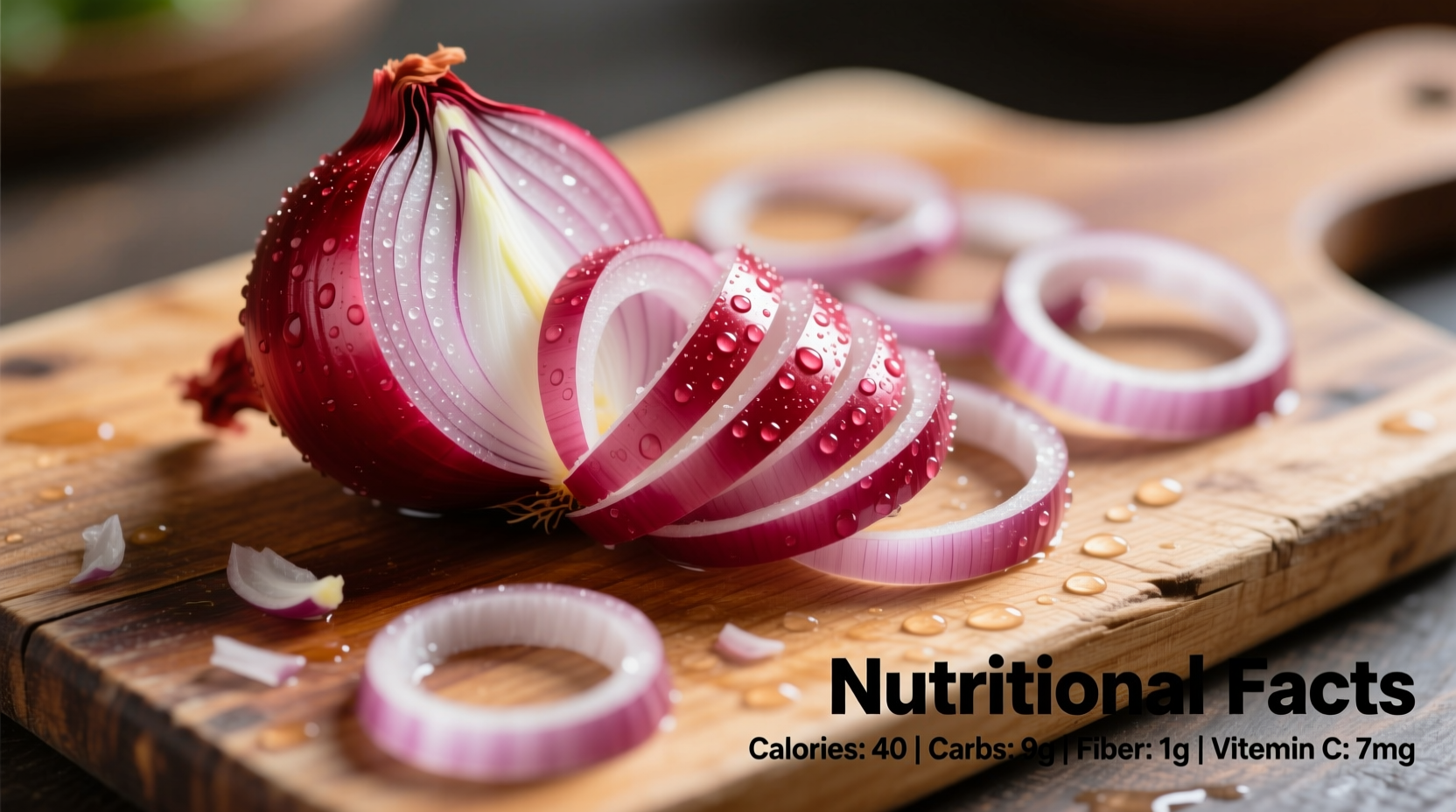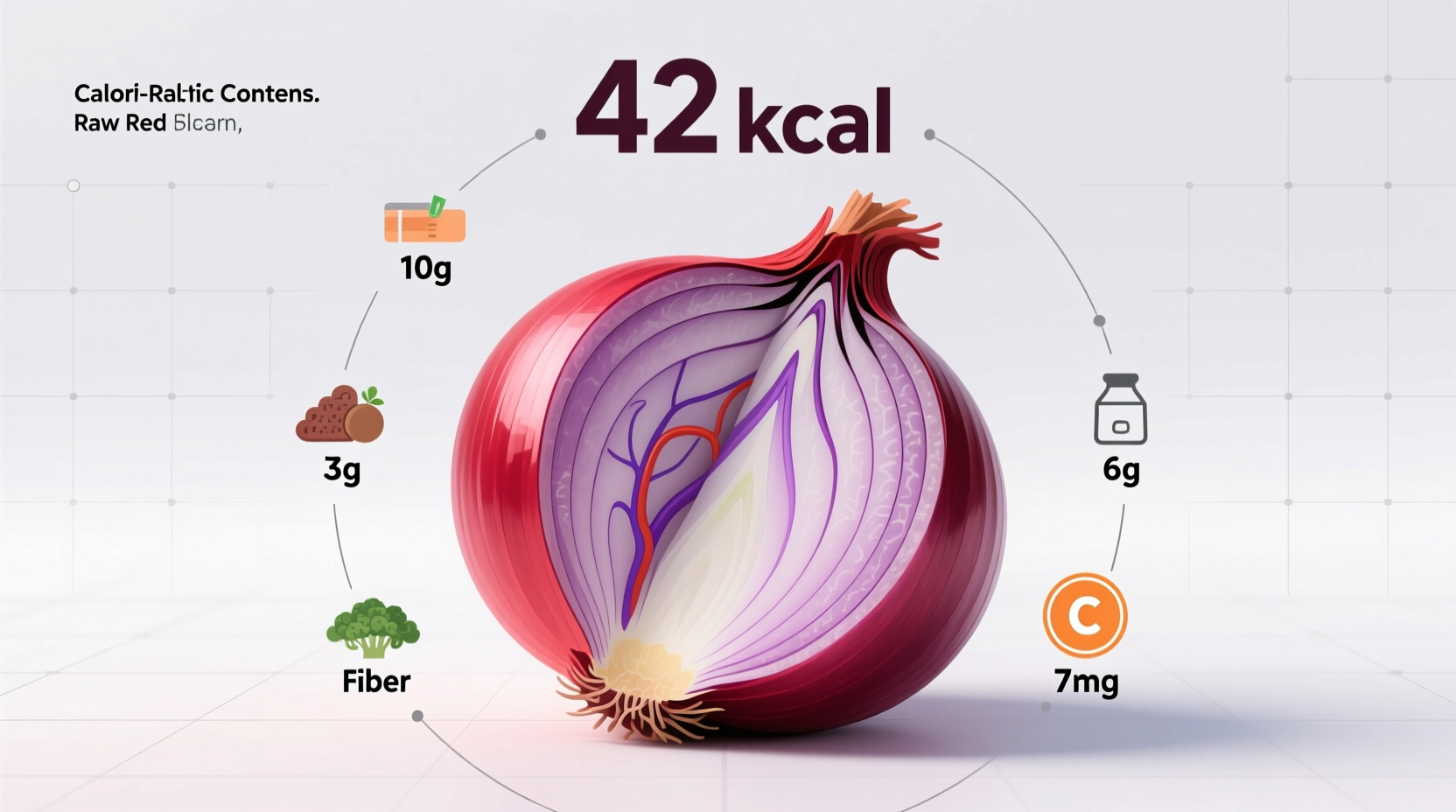Understanding the exact calorie content of ingredients is crucial for meal planning, dietary tracking, and maintaining a balanced nutrition profile. Red onions, with their distinctive purple hue and slightly sharper flavor compared to yellow or white varieties, offer a flavorful yet minimal-calorie option for health-conscious cooks and eaters.
Nutritional Profile of Red Onions: Beyond Just Calories
While the calorie count is important, red onions provide significant nutritional value beyond their energy content. According to the USDA FoodData Central database, a medium red onion (110g) delivers:
- 44 calories (as highlighted above)
- 10g carbohydrates including 2g dietary fiber
- 1.2g protein
- Nearly zero fat (0.1g)
- Vitamin C (12% of daily value)
- Vitamin B6 (5% of daily value)
- Folate (4% of daily value)
- Potassium (3% of daily value)
What makes red onions particularly valuable is their rich antioxidant content, especially anthocyanins (which give them their purple color) and quercetin. These compounds have been studied for their potential anti-inflammatory and heart-protective properties.
Comparing Onion Varieties: Calorie and Nutrient Differences
Not all onions are nutritionally identical. Here's how red onions compare to other common varieties:
| Onion Type | Size (grams) | Calories | Carbohydrates (g) | Key Nutritional Differences |
|---|---|---|---|---|
| Red Onion | 110g (medium) | 44 | 10 | Highest anthocyanin content; slightly higher vitamin C |
| Yellow Onion | 110g (medium) | 44 | 10.3 | Higher sulfur compounds; more quercetin when cooked |
| White Onion | 110g (medium) | 46 | 10.8 | Slightly higher carbohydrate content; milder flavor profile |
| Green Onions (Scallions) | 100g | 32 | 7.3 | Higher vitamin K content; lower overall calories per serving |
This comparison comes directly from the USDA's National Nutrient Database for Standard Reference, which nutrition professionals and researchers rely on for accurate food composition data. The minor differences in calorie content between varieties are primarily due to slight variations in water content and natural sugar levels.
How Preparation Methods Affect Calorie Content
While raw red onions maintain their low-calorie profile, preparation methods can significantly impact the final calorie count of your dish:
- Raw consumption: Maintains the natural 44 calories per medium onion
- Grilled or roasted: Concentrates natural sugars but doesn't add calories (still approximately 44 calories)
- Sautéed in oil: Adds significant calories from the cooking fat (1 tablespoon oil = 120 calories)
- Caramelized: Same calorie count as raw, but the natural sugars become more concentrated as water evaporates
- Pickled: May contain added sugar in the brine, increasing calorie content slightly
Professional chefs like myself always recommend tracking added ingredients rather than worrying about the onion's base calories, as the onion itself contributes minimally to the overall calorie count of most dishes.

Practical Applications: Using Red Onions in Your Diet
Knowing that red onions contain just 44 calories per medium bulb opens up numerous dietary possibilities:
- Salad booster: Add substantial flavor and crunch to green salads without significantly impacting calorie count
- Sandwich enhancer: Provides flavor complexity to sandwiches and wraps with minimal calories
- Salsa base: Forms the foundation of fresh salsas with tomatoes and cilantro
- Grain bowl accent: Raw sliced red onions add color and flavor to quinoa, rice, or couscous bowls
- Marinade component: Contributes flavor to meat and vegetable marinades without adding fat
For those following specific dietary patterns, red onions fit well into Mediterranean, DASH, and most plant-based eating approaches. Their low glycemic index (around 10) makes them suitable for blood sugar management when consumed in reasonable portions.
Storage Tips to Maintain Nutritional Value
Proper storage preserves both the flavor and nutritional content of red onions:
- Store whole, unpeeled onions in a cool, dry, dark place with good air circulation
- Avoid refrigeration for whole onions (increases moisture and accelerates spoilage)
- Once cut, store in an airtight container in the refrigerator for up to 7 days
- Freezing raw onions diminishes their crisp texture but preserves nutritional value for cooked applications
- Red onions typically maintain peak nutritional value for 2-3 weeks when stored properly
Research from the Journal of Agricultural and Food Chemistry shows that proper storage helps maintain the antioxidant compounds in red onions, particularly the anthocyanins responsible for their distinctive color and many health benefits.
When Red Onion Calorie Counts Might Vary
While 44 calories for a medium red onion is the standard measurement, several factors can cause slight variations:
- Size differences: Small onions (70g) contain about 28 calories, while large onions (150g) contain approximately 60 calories
- Growing conditions: Soil composition and climate can affect natural sugar content
- Seasonality: Onions harvested in different seasons may have slightly varying water and sugar content
- Preparation method: As mentioned earlier, added ingredients during cooking significantly impact final calorie count
For precise dietary tracking, weighing your onions provides the most accurate calorie calculation. The USDA formula is simple: 0.4 calories per gram of red onion.
Frequently Asked Questions
How many calories are in a small red onion?
A small red onion (approximately 70g) contains about 28 calories. This makes small red onions an excellent low-calorie option for adding flavor to dishes without significantly impacting your daily calorie intake.
Do red onions have more calories than yellow onions?
No, red onions and yellow onions have virtually identical calorie counts. Both contain approximately 44 calories per medium onion (110g). The nutritional differences between varieties are minimal, with red onions containing slightly more anthocyanins while yellow onions have marginally higher quercetin content.
Are red onions good for weight loss?
Yes, red onions are an excellent addition to weight loss diets. With only 44 calories per medium onion, they add substantial flavor, texture, and nutrients without contributing significant calories. Their fiber content (2g per medium onion) also promotes satiety, helping you feel fuller longer on fewer calories.
How does cooking affect the calorie content of red onions?
Cooking red onions doesn't significantly change their calorie content when prepared without added fats. A medium cooked red onion still contains approximately 44 calories. However, if you cook onions in oil, butter, or other fats, the calorie count increases substantially based on the amount of added fat (1 tablespoon of oil adds about 120 calories).
How many carbohydrates are in a red onion?
A medium red onion (110g) contains approximately 10 grams of carbohydrates, including 2 grams of dietary fiber. This makes red onions relatively low in carbs compared to many other vegetables, with about 9 grams of net carbs per medium onion (total carbs minus fiber).











 浙公网安备
33010002000092号
浙公网安备
33010002000092号 浙B2-20120091-4
浙B2-20120091-4